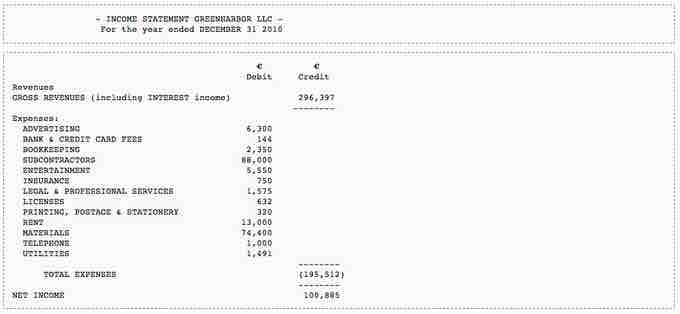Income statement, also referred to as profit and loss statement (P&L), revenue statement, statement of financial performance, earnings statement, operating statement or statement of operations, is a company's financial statement that indicates how the revenue (cash or credit sales of products and services before expenses are taken out) is transformed into the net income (the result after all revenues and expenses have been accounted for, also known as Net Profit or "bottom line"). It displays the revenues recognized for a specific period, and the cost and expenses charged against these revenues, including write-offs (e.g., depreciation and amortization of various assets) and taxes.

Example Income Statement
Income statement Green Harbor LLC
The purpose of the income statement is to show managers and investors whether the company made or lost money during the period being reported. The important thing to remember about an income statement is that it represents a period of time. This contrasts with the balance sheet, which represents a single moment in time.
The income statement can be prepared in one of two methods. The Single Step income statement takes a simpler approach, totaling revenues and subtracting expenses to find the bottom line. The more complex Multi-Step income statement (as the name implies) takes several steps to find the bottom line, starting with the gross profit. It then calculates operating expenses and, when deducted from the gross profit, yields income from operations. Adding to income from operations is the difference of other revenues and other expenses. When combined with income from operations, this yields income before taxes. The final step is to deduct taxes, which finally produces the net income for the period measured.
In addition to the Single and Multi-step methods, the income statement can be reported on a cash or accrual basis. An income statement reported on a cash basis is typically used by smaller businesses that record transactions based on the exchange of cash; the revenues and expenses reported reflects cash received on sales and cash paid for expenses for the accounting period. Larger entities use the accrual basis, which is also the recommended method by the FASB. An income statement under accrual accounting reflects revenues "earned", where an exchange in value among the parties has taken place, regardless of whether cash was received. Expenses on the statement have been "incurred", where the business has received a benefit and has paid for it or has recorded a liability to pay it at a future date. As with revenues, the exchange of cash does not dictate the amount reported for the expense.
Income statements should help investors and creditors determine the past financial performance of the enterprise, predict future performance, and assess the capability of the business to generate future revenue streams through the reporting of income and expenses.
However, information of an income statement has several limitations: items that might be relevant but cannot be reliably measured are not reported (e.g. brand recognition and loyalty). Some numbers vary based on the accounting methods used (e.g. using FIFO or LIFO accounting to measure inventory level). Some numbers depend on judgments and estimates (e.g. depreciation expense depends on estimated useful life and salvage value).
Guidelines for statements of comprehensive income and income statements of business entities are formulated by the International Accounting Standards Board and numerous country-specific organizations, for example the FASB in the U.S.